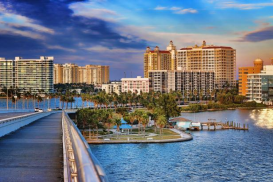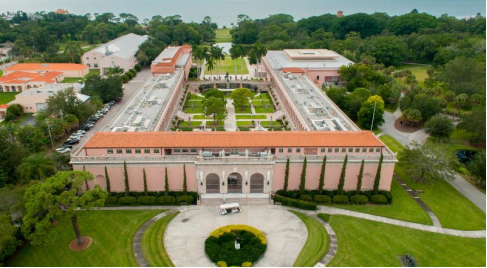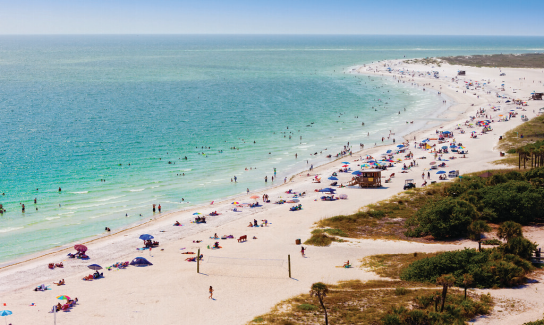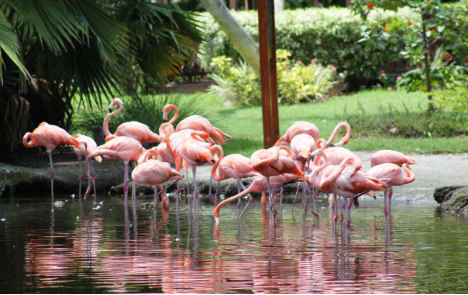Sarasota, Florida 作者: 来源: 发布时间:2021-07-20
I.Population and Area
₋Area
Land: 14.72 sq mi (38.13 km2)
₋Population
Total: 51,917
Density: 3,959.04/sq mi (1,528.61/km2)

II.Natural Geography
₋Sarasota (/ˌsærəˈsoʊtə/) is a city in Sarasota County on the southwestern coast of the U.S. state of Florida. The area is renowned for its cultural and environmental amenities, beaches, resorts, and the Sarasota School of Architecture. The city is at the southern end of the Tampa Bay Area, north of Fort Myers and Punta Gorda. Its official limits include Sarasota Bay and several barrier islands between the bay and the Gulf of Mexico. According to the U.S. Census Bureau, in 2019 Sarasota had a population of 58,285. In 1986 it became designated as a certified local government. Sarasota is a principal city of the Sarasota metropolitan area, and is the seat of Sarasota County. Long the winter headquarters of the Ringling Brothers Circus, many landmarks in Sarasota are named for the Ringlings.
₋The islands separating Sarasota Bay from the gulf near the city, known as keys, include Lido Key and Siesta Key, which are famous worldwide for the quality of their sandy beaches. The keys that are included in the boundary of Sarasota are Lido Key, St. Armands Key, Otter Key, Casey Key, Coon Key, Bird Key, and portions of Siesta Key. Previously, Siesta Key was named Sarasota Key. At one time, it and all of Longboat Key were considered part of Sarasota and confusing contemporaneous references may be found discussing them.
₋Longboat Key is the largest key separating the bay from the gulf, but it was evenly divided by the new county line of 1921. The portion of the key that p arallels the Sarasota city boundary that extends to that new county line along the bay front of the mainland was removed from the city boundaries at the request of John Ringling in the mid-1920s, who sought to avoid city taxation of his planned developments at the southern tip of the key. Although they never were completed in the quickly faltering economy, those development concessions granted by the city never were reversed and the county has retained regulation of those lands.
₋The city limits had expanded significantly with the real estate rush of the early twentieth century, reaching almost 70 square miles (180 km2). The wild speculation boom began to crash in 1926 and following that, the city limits began to contract, shrinking to less than a quarter of that area.

III.GDP
₋The average salary in Sarasota, FL is $17.27. Trends in wages decreased by -0.1 percent in Q1 2020. The cost of living in Sarasota, FL is 9 percent higher than the national average. The most popular occupations in Sarasota, FL are Certified Nurse Assistant (CNA), Registered Nurse (RN), and Licensed Practical Nurse (LPN) which pay between $11.34 and $30.79 per year. The most popular employers in Sarasota, FL are Sarasota Memorial Hospital, Sarasota Memorial Health Care System, and Publix Super Markets Inc.
₋Website: https://www.payscale.com/research/US/Location=Sarasota-FL/Salary
IV.Industrial Characteristics
₋Tourism contributes significantly to the economy of Sarasota. Companies based in Sarasota include the Boar's Head Provision Company. Major employers include Sarasota Memorial Hospital, Doctors Hospital of Sarasota, APAC Customer Services, L-3 Aviation Recorders, The Zenith. Diversified industrial company Roper Technologies is based in Sarasota.
V.Attractions
1.John and Mable Ringling Museum of Art

₋The John and Mable Ringling Museum of Art is the state art museum of Florida, located in Sarasota, Florida. It was established in 1927 as the legacy of Mable Burton Ringling and John Ringling for the people of Florida. Florida State University assumed governance of the Museum in 2000.
₋Designated as the official state art museum for Florida, the institution offers twenty-one galleries of European paintings as well as Cypriot antiquities and Asian, American, and contemporary art. The museum's art collection currently consists of more than 10,000 objects that include a variety of paintings, sculpture, drawings, prints, photographs, and decorative arts from ancient through contemporary periods and from around the world. The most celebrated items in the museum are 16th–20th-century European paintings, including a world-renowned collection of Peter Paul Rubens paintings. Other famous artists represented include Benjamin West, Marcel Duchamp, Diego Velázquez, Paolo Veronese, Rosa Bonheur, Gianlorenzo Bernini, Giuliano Finelli, Lucas Cranach the Elder, Frans Hals, Nicolas Poussin, Joseph Wright of Derby, Thomas Gainsborough, Eugène Boudin, and Benedetto Pagni.
₋In all, more than 150,000 square feet (14,000 m2) have been added to the campus, which includes the art museum, circus museum, and Ca' d'Zan, the Ringlings' mansion, which has been restored, along with the historic Asolo Theater. New additions to the campus include the Visitor's Pavilion, the Education, Library, and Conservation Complex, the Tibbals Learning Center complete with a miniature circus, and the Searing Wing, a 30,000-square-foot (2,800 m2) gallery for special exhibitions attached to the art museum.
₋Address: 5401 Bay Shore Rd, Sarasota, FL 34243, United States
₋Website: https://www.ringling.org/
2. Siesta Beach

₋Siesta Beach (sometimes known as Siesta Key Beach) is a beach located on Siesta Key in the U.S. state of Florida.
₋Unlike beaches elsewhere that are made up mostly of pulverized coral, Siesta Beach's sand is 99% quartz, most of which comes from the Appalachian Mountains. Over time the feldspar and mica have been removed from the rock, leaving almost pure quartz. Even on the hottest days, the sand is so reflective that it feels cool underfoot. According to Harvard University geologists, it's estimated that the sand on Siesta Beach and Crescent Beach on Siesta Key is millions of years old, having its origin in the Appalachians and flowing down the rivers from the mountains until it eventually was deposited on the shores of Siesta Key.
₋The southern portion of Siesta Beach is alternatively called Crescent Beach, which extends to the sea wall and Point of Rocks, an area with coral and active marine life.
₋Siesta Beach is not only long, but also expansively wide, especially around the Siesta Key Beach Pavilion section. The beach is so wide the city installed walking mats to help beachgoers get to the shore, where they can then walk on firmer wet sand.
₋Address: 948 Beach Rd, Sarasota, FL 34242, United States
₋Phone: +1 941-861-5000
₋Website: https://www.siestakeychamber.com/beaches
3. Sarasota Jungle Gardens

₋Sarasota Jungle Gardens is a tourist attraction located in Sarasota, Florida, United States since 1939. The gardens contain over 10 acres (4.0 ha) of botanical plantings along with bird and animal shows. It is open to the public for a per-use ticket fee, as well as offering yearly membership passes for those wishing to visit frequently.
₋In the 1920s, the site was a swampy banana grove listed in city records as "an impenetrable swamp." In the early 1930s, David Breed Lindsay, a local newspaperman, purchased the grove to create a botanical gardens. Beginning in 1936, admission fees were charged and in 1940, Jungle Gardens opened for business in essentially its current form. In the late 1940s, Jungle Gardens was sold to the philanthropic Allyn family, who continue to manage it.
₋Address: 3701 Bay Shore Rd, Sarasota, FL 34234, United States
₋Opened: December 31, 1939
₋Phone: +1 941-355-5305
₋Website: https://sarasotajunglegardens.com/
VI.History
₋Some question seems to exist as to a definite origin of the name “Sarasota”. Legend connects it with Sara, reputedly the daughter of the conquistador, DeSoto. Some have wondered if the name may have originated with an Indian word “sara-se-cota”, meaning a landfall easily observed. Maps in the 1700’s showed the area as “Porte Sarasote” and “Sarazota”. It is also said a fishing camp and Indian trading post at the end of Longboat Key was called “Saraxota”.
₋1831florida map-100x9Use of the name “Sarasota” appears on the first complete maps of Florida printed by the government in 1839, 18 years after the Floridas passed to the United States following ownership by both the Spanish and the British. Long before the name came into question, Indians had discovered the lush area and knew the bounty of the abundant wild fruits and game in the vicinity. Fishermen and traders were not infrequent visitors to the area. Clashes between the whites and Indians in Florida eventually led to the ruinous seven-year Seminole War. It was at the conclusion of the hostilities that Congress adopted the Armed Occupation Act – deeding 160 acres and six months provisions to any person who agreed to carry arms and protect the land for five years.
₋The first permanent white settler in the Sarasota area was William H. Whitaker, who was deeded 144.81 acres on September 1,1851, on Sarasota Bay. Mr. Whitaker, for whom the Whitaker Bayou is named, built his log cabin at “Yellow Bluffs”, so named because of its outcroppings of yellow limestone. The Whitaker cabin was burned to the ground by Seminole raiders in 1865. During the Civil War, raids made life too hazardous and the Whitakers moved northward to Manatee where they stayed until the war ended. The decade and a half between 1868 and 1883, resulted in the initial “large scale” discovery by outsiders of the richness of the Sarasota area. Acreage was cleared by early settlers, orange groves and gardens planted, and herds of cattle joined the Whitaker herd on the rich grazing plains.
₋John Webb moved to the area during this period and opened the first “manufacturing plant” to refine sugar and to produce syrup. Webb also built the first Winter resort with individual guest cottages – advertised in northern newspapers as a special paradise – Webb’s Winter Resort on Little Sarasota Bay. (Today’s Historic Spanish Point.) A small community grew up in Webb’s neighborhood and in 1884, he applied for a post office. The community was named Osprey in accordance with his wishes. The Jesse Knight family settled further down the bay in the area that eventually became the sister communities of Venice and Nokomis. Isaac A. Redd, who had lived in the area in 1857 prior to the war, returned 10 years later to become the founder of Bee Ridge. In 1876, Redd led a movement to establish a missionary Baptist church, which became the first church built in what was to become Sarasota County.
₋Early in the 1870’s, a community began to take shape on the mainland between Hudson Bayou and Phillippi Creek. A post office was established in 1878, and operated under the community named “Sara Sota”. It was in this new community that Miss Caroline Abbe established the first school with an initial enrollment of a dozen students, all taught in private homes prior to a school building being built.
₋In the late 1870’s, the orange industry began to attract attention and the citrus industry established a community called “Fruitville”, with Charles L. Reeves as the first homesteading settler in 1876. The Swampland Act, through a loophole, reduced drastically the effectiveness of the Homestead Act and practically halted the influx of settlers. By the end of 1883, nearly 700,000 acres had been deeded to land speculators for as little as 25 cents an acre. But with the halt of the rugged pioneers, a new type of colonization was attempted.
₋The Florida Mortgage and Investment Company of Edinburgh purchased 60,000 acres and selected Sara Sota as the key point for its development. Scottish colonists arrived in December of 1885, but sorrow and hardships left them disenchanted with their new land. In 1886, the colony had dwindled to only three families, plus a few individuals.
₋In that same year, John W. Gillespie arrived, and his company, Florida Mortgage and Investment Co., Ltd., would make an attempt to revive the colony. Steamship connections were established with Tampa. Mr. Gillespie built the De Soto Hotel, and he laid out what was perhaps the first practice golf course in America.
₋Fishing as an industry began to flourish. Channels were dredged in a move to improve water commerce and shipping. The Spanish-American War in 1898 added to the prosperity, as cattleman drove herds to slaughter to supply meat for the hungry soldiers.
₋Sarasota got its first newspaper in 1899. In November of that same year, telephone service arrived. A line from Manatee to Sarasota was installed by the Gulf Coast Telephone Company. A year later the line was extended to Fruitville and then Myakka.
₋The Seaboard Railroad extended its line from Tampa to Sarasota at least five years earlier than it had planned, motivated by the news that Ralph Caples, a well-known railroad entrepreneur, indicated that he planned to build the line himself following his honeymoon vacation to Sarasota in 1899.
₋Sarasota was incorporated as a town on October 14, 1902, and Mr. Gillespie served as the Town’s first Mayor. He was subsequently elected to five additional one year terms. In addition to the railroad connection, the town boasted a yacht club, a new school, and ice plant, a cemetery, theater, municipal water works, electric plant, a second newspaper, and a sanitarium opened by John Halton in 1908.
₋Sarasota Key was changed to Siesta Key in 1907, but it wasn’t until 10 years later that the new Siesta Bridge opened up the island to any significant development.
₋Mrs. Potter Palmer and her family visited Sarasota in 1910. They liked the location so much; they decided to purchase some 80,000 acres in the area which was at that time part of south Manatee County. She established her cattle ranch called “Meadow Sweet Pastures” after building her home named “The Oaks” on the old Webb property on Little Sarasota Bay in Osprey.
₋John and Charles Ringling, of the famous circus family, invested in Sarasota property two years later, just a year before Sarasota was incorporated as a city on May 13, 1913.
₋Tourists were now coming in a steady stream. This new influx of tourism, and the extensive Palmer and Ringling investments, stirred new interests among the residents and thus began the drive to separate from Manatee County and establish a distinct identity as a whole new county. Sarasota County was established in 1923, through a special act of the State Legislature. The City of Sarasota was then designated as the county seat in an election held November 18, 1924.
₋When the Florida land boom ended, Sarasota had three large modern hotels, a high class business district, scores of apartment houses, hundreds of fine new homes, 77 miles of paved streets, a municipal golf course, a hospital, a good school system, bridges running from the keys to the mainland, and improved rail and boat transportation systems.
₋In the tough years of the Great Depression, Sarasota received its first Works Progress Administration (WPA) project in 1935, which funded a drainage project for the city golf course. Two years later, in 1937, came the an even more valuable WPA project – development of Bayfront Park and construction of the Municipal Auditorium, and later, the Lido Beach Casino was opened.
₋lidocasino002Work on the Manatee-Sarasota Airport was started in 1938. The airport became a military airfield during World War II, with 3,000 servicemen stationed there. The end of the war served to open the area even further through an ever expanding tourism industry.
₋Spectacular growth during the “Stunning Sixties” carried through well into the seventies. The recession in the late ’70s resulted in tough times for some area businesses. Sarasota’s Downtown was hit hardest with many of the existing stores closing their doors. However, in the late ’80s and especially the early ’90s the economy shifted and the Downtown began to prosper again. Sarasota now boasts one the finest downtowns in the State of Florida.
₋Website: https://historicpreservationsarasota.org/sarasotahistory/
VII.Other Information
₋Airports
₋The major airport in the area is Sarasota-Bradenton International Airport which is shared by Sarasota and Manatee counties. It has since being opened in 1941 the areas major airport. Before this, Lowe's Field functioned as the main airport for the Sarasota Area from 1929–1941. Five airlines offer service out of the airport to locations primarily in the United States and Canada. The airport serves more than 1,300,000 passengers per year. The airport holds full port of entry status providing U.S. Customs inspections for international travelers. St. Petersburg-Clearwater International Airport and Tampa International Airport are located about an hour north from Sarasota, and Southwest Florida International Airport in Ft. Myers an hour and 45 min south of Sarasota. All 3 offer a wider range of national and international flights.
₋Public transit
₋Sarasota County Area Transit has a bus service called SCAT which offers service throughout the county and also offers limited connections with Manatee County Area Transit. Sarasota County has joined the Tampa Bay Area Regional Transportation Authority to plan and build future transportation infrastructure including light rail, commuter rail and longer range bus service.
₋Rail
₋A key issue is providing Sarasota with access to the Florida High Speed Rail. The Seaboard Coast Line ran intercity train service to the city until 1971. There is no Amtrak train which stops in Sarasota, but Amtrak provides through-bus service at Sarasota Station, located approximately 2 miles (3.2 km) from the city limits of Sarasota, to the nearest Amtrak terminal in Tampa. A freight-only rail line operated by Seminole Gulf Railway does serve industries in Sarasota.
₋Water
₋As a city located on the Gulf of Mexico, water transportation is a key consideration. The Intracoastal Waterway is a 3,000-mile (4,800 km) waterway providing water access to and from the Atlantic coast for tugs, barges and leisure boats. Port Manatee and the Port of Tampa both provide nearby deep water ports. Port Manatee provides cargo service primarily while the Port of Tampa is more diverse. Port Manatee formerly even had a cruise line, Regal Cruise Line that operated out of in from 1993–2003 until it was seized by U.S Marshals on April 18, 2003 for not being maintained. The waterway enters Sarasota Bay which provides access to downtown Sarasota at the city pier.
VIII.Contact Information
₋Government
Type: Commission–manager government
City Mayor: Jen Ahearn-Koch
₋City Hall
₋ADDRESS:
1565 1st St.
Sarasota, FL 34236
₋PHONE: (941) 365-2200
₋Website: https://www.scgov.net/Home/Components/FacilityDirectory/FacilityDirectory/710/
